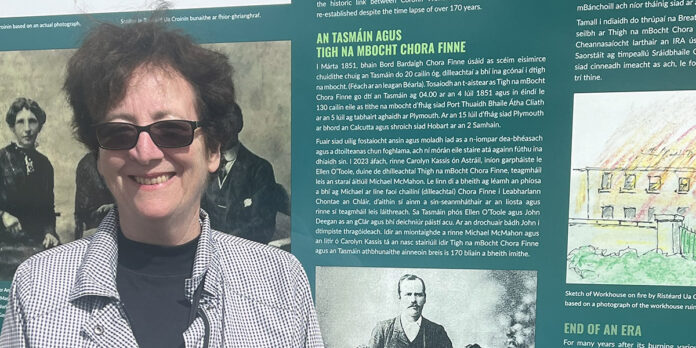The great-great-granddaughter of two orphan girls, who departed the Corofin Workhouse on July 5, 1851, made a 17,000 kilometre return journey home yesterday, bringing to a close a 173 year old mystery.
Mary Pecker (nee Deegan) from Adelaide in Australia stood at the Corofin Workhouse yesterday morning, and looked upon the same stone façade that her ancestors looked upon the day they left Clare for Van Diemen’s Land, or modern day Tasmania.
This remarkable journey was made possible thanks to the work of local historian Michael Mac Mahon and Cumann Staire is Dúchais Chora Finne, who have worked tirelessly to find out what happened to 20 orphan girls who left Corofin in 1851.
Cumann Staire is Dúchais Chora Finne unveiled a heritage board at the Corofin Workhouse late last year, which included information about Ellen O’Toole, who left the Corofin Union Workhouse at 4am on the morning of July 4, 1851.
Mac Mahon has worked tirelessly over the years to track the orphans’ passage to Dublin, Plymouth and on to Hobart in Australia. Indeed, as a result of his work, descendants of some of these orphans have recently made contact with him, including Australian woman, Mary Pecker (nee Deegan).
“I have always had a passion for family history. When I was pregnant back in 1994, I started researching this history and I discovered that John Deegan was my great-great-grandfather, and he was a convict. My father had no idea, I suppose the family don’t tell the next generation that they are criminals,” she told The Clare Champion.
“I was tracing who he married and that is when I came across Ellen O’Toole. I was pregnant at this time and I named our daughter Clare-Ellen in her honour.
“I have since learned that another of my ancestors was also in the workhouse. Her name was Biddy Meer and she travelled with Ellen O’Toole to Australia. I really now want to learn more about her story, because I know very little.
“She married a convict called William Callaghan in Hobart, and they were married in the same church as Ellen and John Deegan. Their children, Ellen’s son Charles Deegan, married Biddy’s daughter, Sarah Jane. So in Hobart the Irish from Corofin really stuck together.
“I am feeling very emotional about all of this. I can’t imagine the hardship that they faced to be in the workhouse in the first place, but then the fact that they made that journey to Van Diemen’s Land which would have taken them weeks and weeks.
“They were very brave women. I know that Ellen ended up on the west coast of Tasmania, in a place called Queenstown, after the death of her husband John Deegan, who tragically died in a boating accident and left her as a widow with her eight living children.
“The west coast of Tasmania was a really bleak, frontier place at the time. It was all about felling trees ad building railways, a very difficult life. I have been to where she is buried in Queenstown Cemetery and Biddy Meer is buried in Hobart.
“I think they were really remarkable women to do what they did. Incredible women. I learned that Ellen’s brother Patrick also came out to Australia. Patrick was also in the workhouse for a short time and he lived with Ellen for a time in Queenstown.
“I’m not sure when he came out, but he did.”
Andrew Hamilton is a journalist, investigative reporter and podcaster who has been working in the media in Ireland for the past 20 years. His areas of special interest include the environment, mental health and politics.


